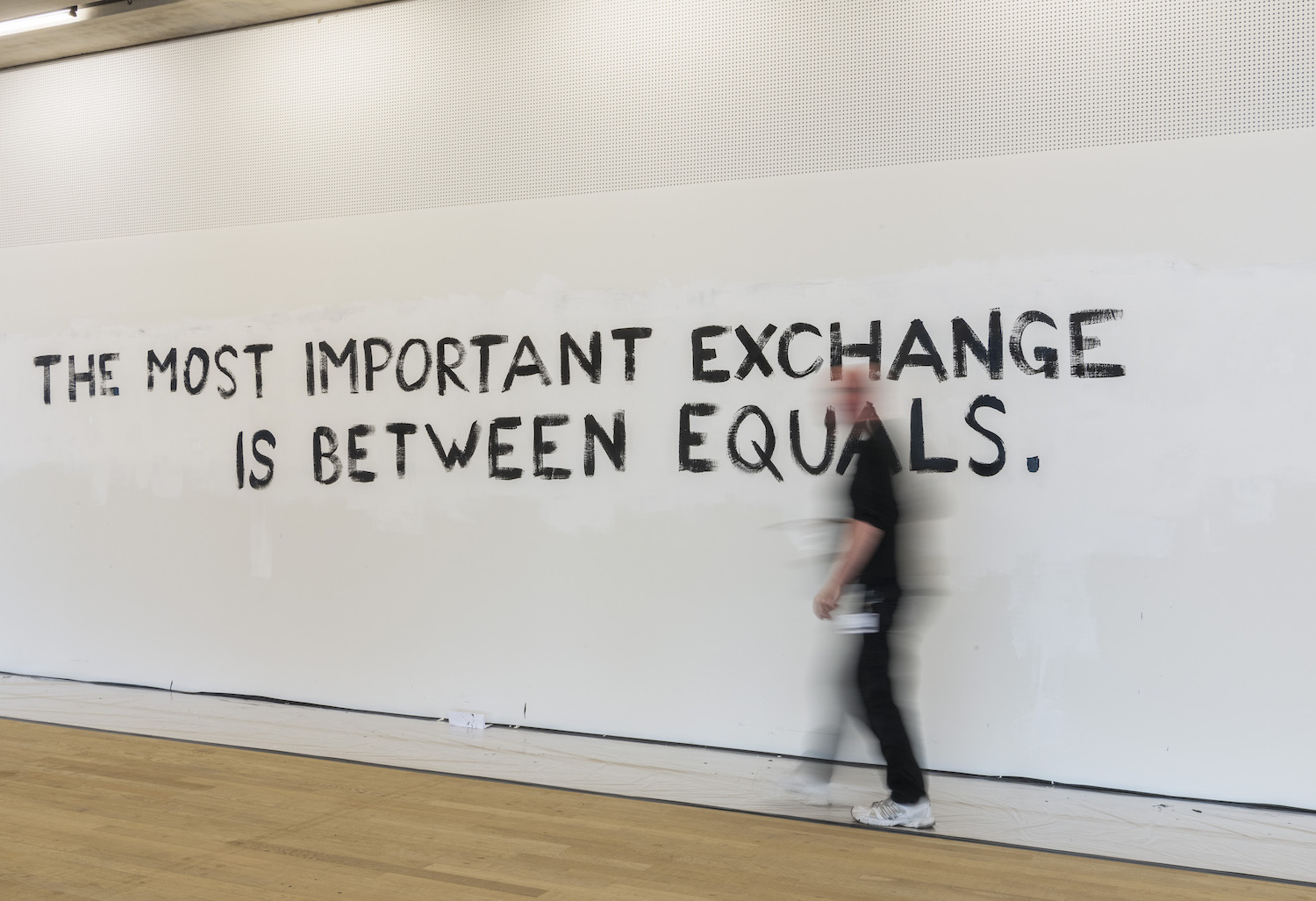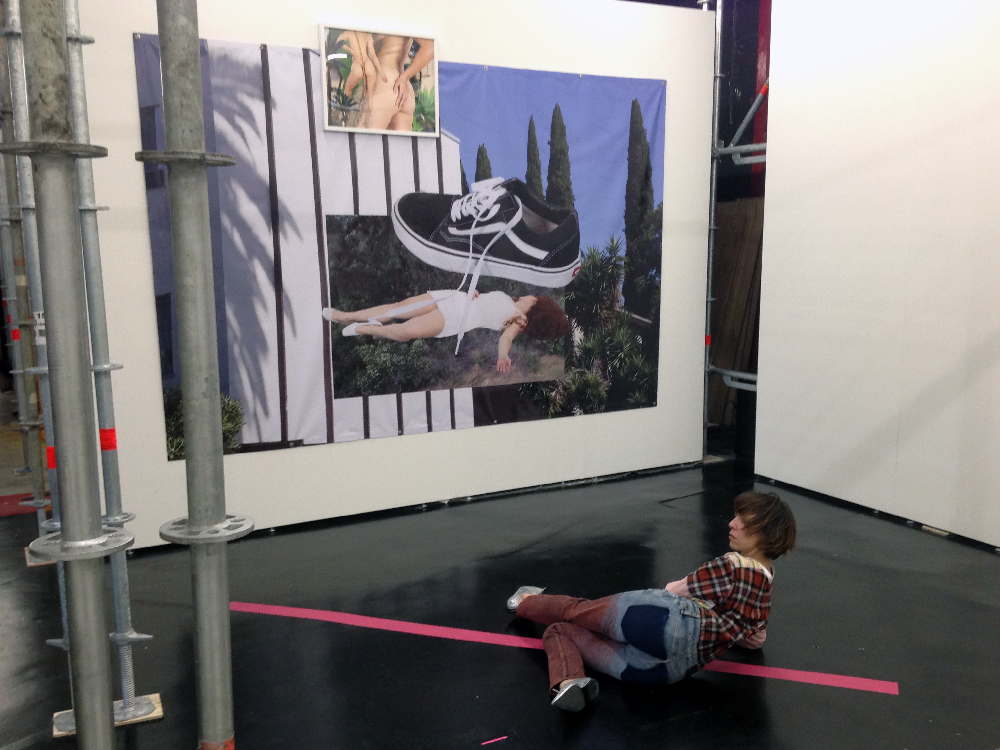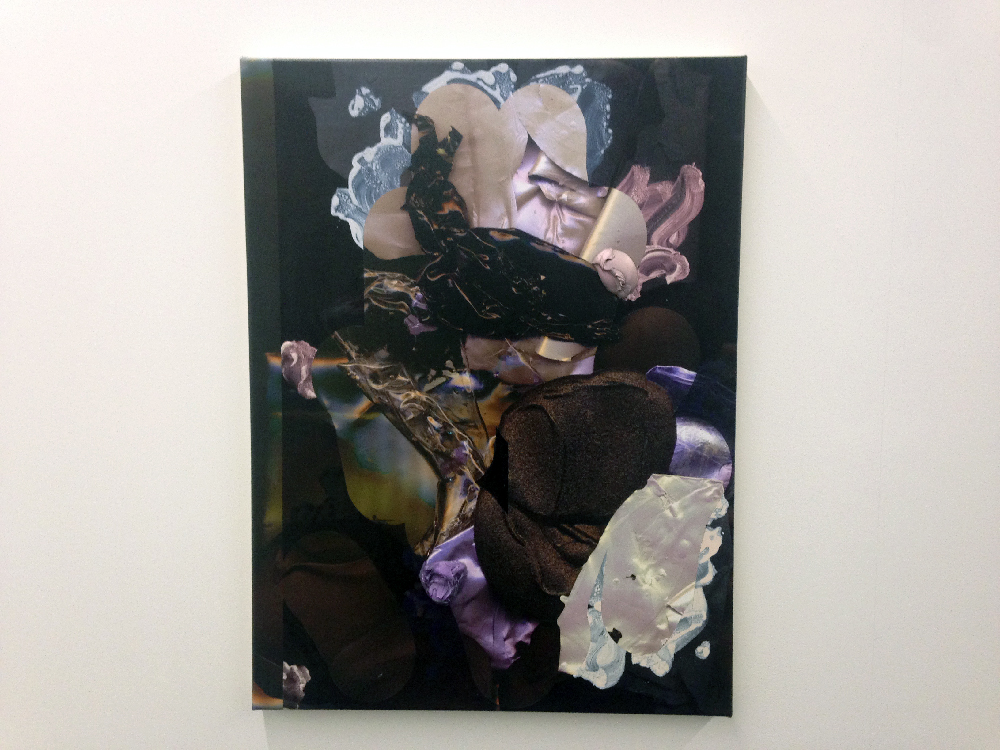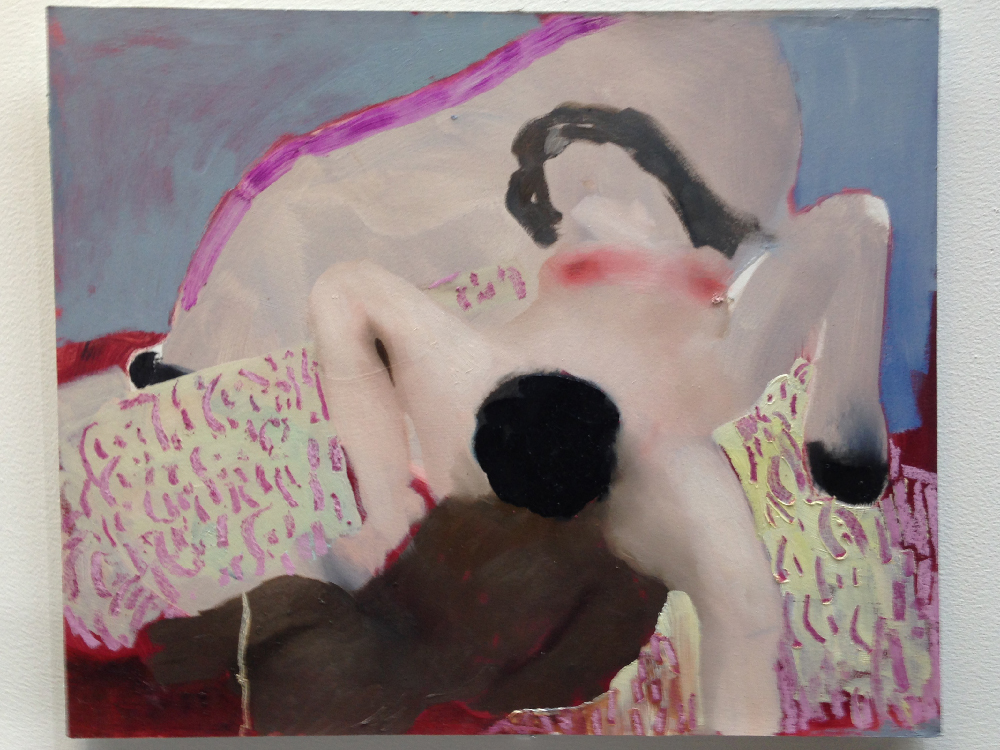Highlights from Material Art Fair by Michael Anthony Farley [UPDATED]
Material can be a difficult fair to photograph (sorry).
But the reasons for this are the best kind.
Material was packed with so much good, engaging work (definitely of a higher caliber than last year) it can be overwhelming. It’s also packed with good, engaging people—refreshingly, it’s one of the least pretentious and friendliest art fairs out there. Repeatedly, chatty gallerists explained that they view Material first-and-foremost as a networking opportunity rather than a traditionally sales-based commercial art fair.
The social aspect of the fair means people actually want to linger as opposed to the usual art fair ritual of fleeing the fluorescent lighting as soon as possible. I came to Material on opening day and it was basically impossible to get all the photos I wanted because of the sheer volume of visitors. Closing day proved just as popular. Contrast this with the fair’s big sister, ZonaMACO, which at times felt eerily empty in its airport-like space far from the center of town [more about that later].


This year, crowds were funneled through a grown-up jungle gym of scaffolding, the fair’s latest and most ambitious collaboration with architecture firm APRDELESP. This strategy transformed Frontón México (a restored art deco jai alai court on charming Plaza de la República) into something akin to a Borg cube from Star Trek.
It was big step up from the last edition of the fair, which felt a little diluted after being dispersed among two floors of the somewhat grim Expo Reforma event space on a shabbier street a few blocks away. As in some years past, the temporary architectural interventions emphasized intimate spaces to experience artworks in relation to one another over ease-of-Instagram-ability—which I really appreciated as a viewer, even as I struggled a few times to get good angles of booths from the shoulder-to-shoulder, bouncy catwalks. As much fun as the temporary structure facilitated, it also induced ocasional panic for those of us with bad memories of last September’s earthquakes.
For those who braved the maze, rewards were abundant. Some highlights below: This giant wig from Isaac Olvera, looming over BOLD’s booth, was a real crowd-pleaser. This wig was part of a series fabricated in Mexico City last year and sent to different outdoor locations in London to be “styled” by the elements of Britain’s climate. Accompanying the hair, a video loop showed the wigs alternately billowing against the London skyline and a drag-esque performance by the artist.
This giant wig from Isaac Olvera, looming over BOLD’s booth, was a real crowd-pleaser. This wig was part of a series fabricated in Mexico City last year and sent to different outdoor locations in London to be “styled” by the elements of Britain’s climate. Accompanying the hair, a video loop showed the wigs alternately billowing against the London skyline and a drag-esque performance by the artist.
 R/SF Projects had a tight booth featuring digital prints on fabric and creepy CGI-looking sculptures of severed heads by Peter Wu and this two-channel video installation by Simón García-Miñaúr. Miñaúr’s work was split between two flat-screens on opposite sides of a pole, each featuring homoerotic animations of bald men in neoclassical ruins. When the doppelgangers caress, their skin shivers and morphs. It’s alternately seductive, creepy, and funny.
R/SF Projects had a tight booth featuring digital prints on fabric and creepy CGI-looking sculptures of severed heads by Peter Wu and this two-channel video installation by Simón García-Miñaúr. Miñaúr’s work was split between two flat-screens on opposite sides of a pole, each featuring homoerotic animations of bald men in neoclassical ruins. When the doppelgangers caress, their skin shivers and morphs. It’s alternately seductive, creepy, and funny.
 Simón García-Miñaúr at R/SF Projects
Simón García-Miñaúr at R/SF Projects
Andre Hemer at Neon Parc
Melbourne gallery Neon Parc had a solo booth featuring these mixed-media works by Andre Hemer. Wandering the fair, I found myself thinking a lot about the catalogue text from the fantastic exhibition The Most Beautiful Part at Museo de Arte Moderno. The introduction claims that Mexican collectors surprisingly shy away from works on paper, especially photography.
At Material—as well as Zona MACO and basically every gallery and pop-up exhibition in the city—there are bountiful examples of photography-cum-object that might indicate a market adaptation to this phenomenon. Or perhaps just a general push-back against the ubiquity of disembodied digital images we´re bombarded with on the daily? Hemer’s work, for example, comprises rich macro photographs of seductive textures with physical globs of paint. They evoke satin and have a decadent (if not a bit on-the-nose) quality.

 Thomas Mailaender’s work at Paris’s Chez Mohamed accomplished the image-as-object switcharoo with a few more conceptual layers. These works evoke ancient pottery fragments, but have been printed with photo-enamel images of the meme era. Each depict tourists behaving “disrespectfully” to ancient monuments, or in my personal favorite, a coffin being carried through a Mexico City subway turnstile. These are funny and a little sad—a fitting find for a future archaeologist studying the decline of Western civilization?
Thomas Mailaender’s work at Paris’s Chez Mohamed accomplished the image-as-object switcharoo with a few more conceptual layers. These works evoke ancient pottery fragments, but have been printed with photo-enamel images of the meme era. Each depict tourists behaving “disrespectfully” to ancient monuments, or in my personal favorite, a coffin being carried through a Mexico City subway turnstile. These are funny and a little sad—a fitting find for a future archaeologist studying the decline of Western civilization?
Mailander’s other piece in the show features a portrait of a woman sunburned into a man’s torso. Talk about alternative process emulsion!
From the curators:
“Exploring a form of archaic archeology, AZTECH unfolds in an ‘Indiana Jonesesque’ landscape where walls and buildings are progressively reclaimed by a dense and profound jungle. Sunburt fallen conquistadors lay besides piles of broken lava upon which we discover images, whilst humid marble carvings of a lost city appear from under the shrub and foliage.”
 Left: Thomas Mailander, “Illustrated People #9” (detail below). Right: Cécile Di Giovanni, “Breaking News”
Left: Thomas Mailander, “Illustrated People #9” (detail below). Right: Cécile Di Giovanni, “Breaking News”
IMMATERIAL performance
This year’s IMMATERIAL performance program included a piece by choreographer Mårten Spångberg entitled “Herradura Reposado” that felt like the reward for climbing to the top of the art-cube-video-game-structure. Performers wandered around seemingly aimlessly to pop music and then burst into synchronized dance moves atop a likely-slippery field of playing cards and blankets.
I couldn’t figure out why I liked this so much (apart from the fact that it looked like so much fun) until I watched this with theater artist (and former Baltimorean!) Elizabeth Hollon and she remarked “this is great because it seems so casual and spontaneous at first and then shocks you with how choreographed and rehearsed it is”.

Mexico City gallery LABOR showed this print of documentation from Héctor Zamora’s recent show at the nearby Museo del Chopo. There was a really odd moment of double-identification here: the image is both instantaneously recognizable from that epic performance/installation and remarkably resemblant of its new context at the fair.
Another of the best examples of photography-based practices incorporating the hand: Rodrigo Valenzuela at Portland’s Upfor gallery. These large works are toner transfers of photos Valenzuela shot in various deserts across the Americas, to which he’s added references to architectural space in acrylic and chalk. The artist told me, “I like to think about landscapes where I would build a house.”
 The other best trend everywhere in fairs and galleries in CDMX this week: giant weird wall-hanging fibers pieces. This one from Andrés Bedoya at New York gallery Situations’ booth is a weaving made of weave.
The other best trend everywhere in fairs and galleries in CDMX this week: giant weird wall-hanging fibers pieces. This one from Andrés Bedoya at New York gallery Situations’ booth is a weaving made of weave.
 LA’s 5 Car Garage had a really tight booth, featuring a wall-hanging quilt and geode sculptures by Kyla Hansen and paintings on bedsheets inspired by vintage porn by Max Maslansky. The geode sculptures are all assembled from industrial waste such as car parts scavenged from Hansen’s rural community.
LA’s 5 Car Garage had a really tight booth, featuring a wall-hanging quilt and geode sculptures by Kyla Hansen and paintings on bedsheets inspired by vintage porn by Max Maslansky. The geode sculptures are all assembled from industrial waste such as car parts scavenged from Hansen’s rural community.
Meanwhile upstairs, Ambera Wellmann at Ed Video (Guelph, Canada) was showing some equally sexy paintings that floated between painterly abstraction and scrambled porn. These are so lovely in person.
 Chelsea Culprit at Mexico City’s bwsmx
Chelsea Culprit at Mexico City’s bwsmx
 LTD Los Angeles opted to curtain-off their booth with these paintings on insect-repelling vinyl by Chloe Seibert. I like that they are kind-of-trendy painting that actually would have a practical application in a home, and that the insecticidal yellow serves as the backdrop for emoji-like faces. I kind of zoned-out watching a friend caress this, thinking about industrial materials, toxicity, and emojis and vaguely remembered a story someone told me about iPhones being full of adhesives that cause neurological damage to factory workers. Probably not what Seibert was going for, but I was impressed that such a simple gesture could conjure such a wide-casting range of associations based on its relationship to the body.
LTD Los Angeles opted to curtain-off their booth with these paintings on insect-repelling vinyl by Chloe Seibert. I like that they are kind-of-trendy painting that actually would have a practical application in a home, and that the insecticidal yellow serves as the backdrop for emoji-like faces. I kind of zoned-out watching a friend caress this, thinking about industrial materials, toxicity, and emojis and vaguely remembered a story someone told me about iPhones being full of adhesives that cause neurological damage to factory workers. Probably not what Seibert was going for, but I was impressed that such a simple gesture could conjure such a wide-casting range of associations based on its relationship to the body.
 Also in LTD Los Angeles’ booth: these massive prints by Chanel Von Habsburg-Lothringen, one of my favorite rising photo stars. Her work has this capacity to inspire really strange narratives while simultaneously having a sleek normcore sensibility. I like this one below even better with performance art happening in front of it:
Also in LTD Los Angeles’ booth: these massive prints by Chanel Von Habsburg-Lothringen, one of my favorite rising photo stars. Her work has this capacity to inspire really strange narratives while simultaneously having a sleek normcore sensibility. I like this one below even better with performance art happening in front of it:
These performers were installed around the fair by artist Maria Hassabi, and were described as “long-durational dance works” by the fair’s print materials. I am not sure how I feel about this piece, because for a gesture with as little conceptual payoff as someone laying on the floor it seemed to be pretty disruptive to human traffic flow. But the silver shoes are really nice.
 Anabel Juarez at Parisian gallery Lefebvre et Fils
Anabel Juarez at Parisian gallery Lefebvre et Fils
Annika Rauhala’s video “Riot Police” casts a voyeuristic stare at the usually anonymous bodies of militarized cops. Occasionally, though, one turns his head and we get a glance at the gaze being returned. Every time I swung back to Helsinki’s Muu Galleria to watch this, the headphones were occupied, but I like to imagine that the audio component is something creepy and sexy, like mid-2000s electroclash.
 Terrence Musekiwa and Justin Orvis Steimer at Catinca Tabacaru (New York/Harare)
Terrence Musekiwa and Justin Orvis Steimer at Catinca Tabacaru (New York/Harare)
 José León Cerrillo at joségarcía ,mx
José León Cerrillo at joségarcía ,mx
I first saw Cerrillo’s work at joségarcía ,mx’s impressive brick-and-mortar location almost exactly two years ago. It’s interesting to see the transition in that time from 2-D works made with more humble materials (alongside higher-production value sculpture) to these sleek, very art-fair-esque prints on cut metal. I am not convinced these are as charming as his other works I’ve seen, but they’re still really nice.
 Keith Boadwee and Club Paint at City Limits, of Oakland, CA. This painting is appropriately titled “Green Chair with Tits” and narrowly beats-out Boadwee’s painting of cats having oral sex as my favorite from the booth.
Keith Boadwee and Club Paint at City Limits, of Oakland, CA. This painting is appropriately titled “Green Chair with Tits” and narrowly beats-out Boadwee’s painting of cats having oral sex as my favorite from the booth.
 Speaking of strange animal sexuality, this painting exists. It’s by Magdalena Kita, shown by Cologne’s SYNDICATE gallery. Kita’s work is not really my cup of tea, but it was explained to me that she uses labor-intensive archaic processes involving tempera and gold-leaf. The icon painters of yesteryear would be proud.
Speaking of strange animal sexuality, this painting exists. It’s by Magdalena Kita, shown by Cologne’s SYNDICATE gallery. Kita’s work is not really my cup of tea, but it was explained to me that she uses labor-intensive archaic processes involving tempera and gold-leaf. The icon painters of yesteryear would be proud.
 Mexico-City-based digital art editioners Janet40.
Mexico-City-based digital art editioners Janet40.
 Alter Space had a lovely booth with felt pieces by Brook Hsu and silkscreens on found images by Matt Borruso. This booth was a good example of affordably-priced, totally sale-able work that seemed to get a lot of attention but had seen slow sales. This is a problem that’s somewhat endemic to Material and I’m not quite sure why—nearly every gallery I spoke with reported the same. [See update below]
Alter Space had a lovely booth with felt pieces by Brook Hsu and silkscreens on found images by Matt Borruso. This booth was a good example of affordably-priced, totally sale-able work that seemed to get a lot of attention but had seen slow sales. This is a problem that’s somewhat endemic to Material and I’m not quite sure why—nearly every gallery I spoke with reported the same. [See update below]
I thought of a conversation I had with Paddy Johnson when we visited the fair two years ago and hailed it as “The Most Important Art Event of the Year for Artists“. We praised the fact that the affordability of Material’s booths keeps work refreshingly on the experimental side (often far more experimental and less market-friendly than Alter Space’s offerings) and noted that NADA’s model can be easily replicated. But if galleries are paying to participate and not making a return on their investment, perhaps other economic models might need to be explored? I hope Material keeps attracting top-notch curatorial and artistic talent—it’s an important discursive event—but that might be a challenge if it’s financially unsustainable for exhibitors. Even if the fair itself (and Mexico City in general) is affordable, everything from shipping costs to time commitments aren’t necessarily for many of the emerging galleries that give this fair its character. This is a recurring problem for basically all of the artist-centric art fairs I actually enjoy going to (Satellite in Miami comes to mind). Of all the art events out there, though, Material seems best poised to figure out how to strike a balance between business and pleasure.
[UPDATE/CORRECTION: The feedback fair organizers received was that sales were actually really strong this year, including several sold-out and nearly sold-out booths. That wasn’t the impression I received from the sample of gallerists I spoke with, who were usually the people not already occupied speaking to someone else (such as collectors). Apologies. I asked fair co-founder Brett W. Schultz what specifically was doing well this year, and he reported strong sales on the higher end from “young(er) artists with an already evident trajectory and curriculum” as well as smaller works snatched up by aspiring collectors. Painting and sculpture obviously made up the biggest percentage of successful sales, but even a few notoriously hard-to-sell videos changed hands this year! This is great news, as it’s nice to see success coming to a fair that’s always attracted emerging gallerists—many of whom have participated in the fair circuit as a labor of love and networking opportunity without reaping much in the way of monetary rewards in the past.]
 Cristine Brache at Fierman
Cristine Brache at Fierman











